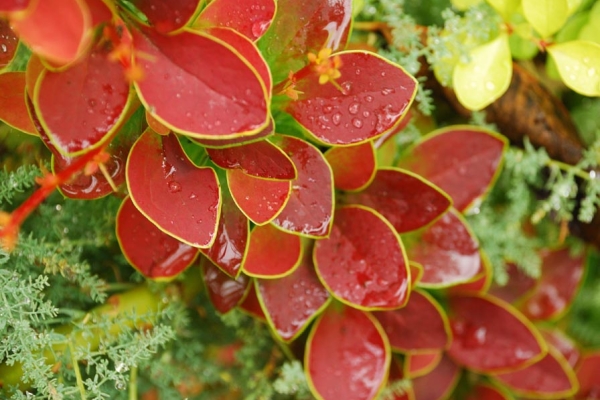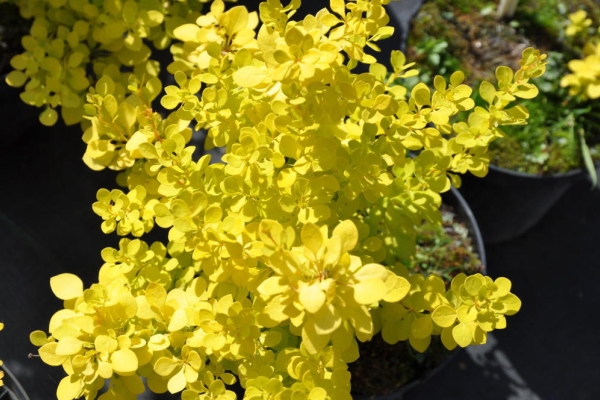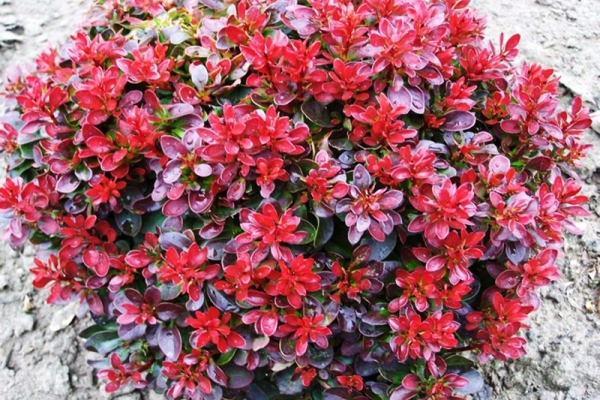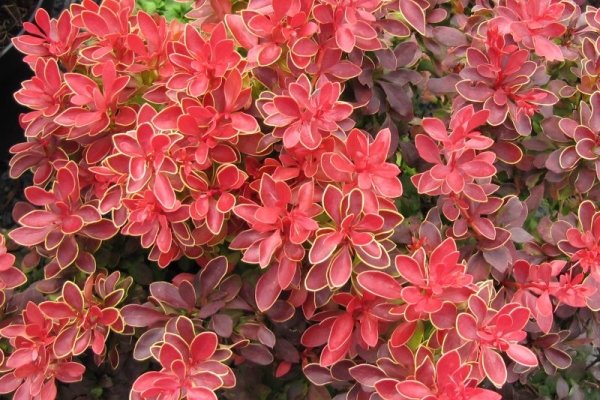A bright decoration of the summer cottage or garden plot will be Thunberg barberry. Below, its advantages and disadvantages will be considered and a description of the best varieties will be given.
Table of contents
Description of the variety
Barberry Thunberg - deciduous shrubs of the family Barberry up to 2 m high comes from the Far East. In the cultivated form of the plant can be found in almost all corners of our planet.
This type of barberry has small rounded or spatulate leaves, painted in green, red or yellow, depending on the variety. Arcuate shoots are dotted with centimeter elastic spines, rarely located.
Bush blooms in late May and blooms almost until the end of June. The petals of the corolla are painted yellow, the outside is slightly cast red. Small flowers have a single arrangement or are collected in small inflorescences of 3-5 pieces.
After the end of the flowering period, the ovaries are formed, from which the fruits develop - shiny red berries of an oblong shape. Crop ripens in autumn from September to October.
Features of barberry Thunberg:
Planting and caring for the barberry Thunberg
In the care of the drumhead Thunberg unpretentious. It grows best in places completely open to the sun, but can tolerate light shading.
It is desirable to protect the plant from drafts and strong winds.The soil should be light, air and moisture permeable.
If on a plot where planting is planned, heavy, dense soil, it is recommended to fill the landing pits with suitable soil that can be independently prepared from sand, humus and sod land (1: 1: 2).
With the exception of a long drought, barberry does not need watering. Occasionally, the soil around the bushes can be slightly plowed. It is mulched by the winter, falling asleep with a layer of compost, sawdust or bark.
Once a year in the spring, organic fertilizers are applied.. In pruning, also carried out in the spring, need only bushes with a loose crown in order to form it and shoots froze over the winter.
Barberry Thunberg - planting and care features:
Advantages and disadvantages
The main advantage of the barberry Thunberg is its decoration. The shape of the crown, the color of leaves, compact bush - barberry just created for use in landscape design.
It is used in the design of borders, alpine slides, hedges, it is good in combination with other plants, and as a single accent.
This also contributes to a huge variety of varieties that differ in density, height and color of the crown.
In addition, this type of barberry is more resistant to the most common pests of this family - rust and powdery mildew.
The main disadvantage of the barberry Thunbergas other members of this family, according to gardeners, is its prickliness.
In this regard, the work on caring for him (weeding, pruning shoots) and picking fruits is a certain difficulty.
Most varieties of barberry - cold-resistant, but at very low temperatures the tops of the shoots can freeze. This deficiency is eliminated by spring pruning and the shrub is quickly restored.

The most popular species: with red, yellow, green and orange foliage
The barberry of Thunberg is widely used as an ornamental plant, and on sale you can find a variety for every taste and color, of which the most popular are:
- Green leaf varieties - Kobold, Maria, Erect, Kornik, Green Carpet.
- Red leaves – Atropurpurea, Atropurpurea Nana, Bagatel, Red Chief, Red Carpet, Rose Glow, Admiration.
- Yellow Leaf - Aurea, Golden Rocket, Golden Carpet.
Varieties of barberry with red and yellow leaves are best planted in open areas well lit by the sun. In the shade their leaves become greenish and lose their decorative effect.
Green leaf varieties: Kobold, Maria, Erect, Kornik, Green Carpet
Shrubs with green leaves are most familiar to our eyes.
Grade Kobold - dwarf shrub with a dense spherical crown with a height of 50 cm and rich green foliage. It is unpretentious to the soil, tolerates a small drought, the only requirement is good lighting.
Variety Maria has straight shoots up to 1.5 m in height, blooms with yellow flowers with a harsh scent. The plant prefers a light shade and well-drained soil, it has good winter hardiness.
Variety Erecta - Column-shaped shrub up to 1.5 m with a dense crown.Crohn has a pale green color, with age becomes more spreading, but maintains density. When flowering throws flowers with yellow petals inside and reddish outside. The harvest for a long time remains on the branches.

Variety Kornik has a dense crown and straight high (up to 2 m) shoots. Dark green leaves are decorated with fine marble veins. The krone is strongly and unevenly branched. The shrub grows rapidly, adding up to 60 cm in height per year.
Variety Green Carpet - Sprawling shrub up to 1 m high with very dense green foliage. The branches are often not directed to the height, but to the sides.
Flowering takes place almost imperceptibly - small flowers have a dull green shade. This variety grows well in fertile, sufficiently moist soil and requires a lot of sun.
Yellow Leaf: Aurea, Golden Rocket, Golden Carpet
Yellow barberry varieties of the barberry in the landscape look good in group plantings as well as single bushes, standing out with bright color spots.
Aurea variety - bush with dense compact krone up to 1 m high.Yellow foliage has various shades from lemon to golden.
The plant requires diffused illumination, as under the direct rays of the sun can burn, and in the shade the leaves turn green. The variety is drought-resistant, tolerates slight frosts.
Grade Golden Rocket - bright yellow columnar shrub up to 1.5 m. Best of all, the variety grows on neutral soils in sunny or slightly shaded areas.
The plant is frost-resistant, unpretentious in the care and rarely exposed to diseases and pests.
Variety Golden Carpet It has a dense spreading creeping crown up to 1.5 m high. The plant is soil-free, but needs good lighting and does not tolerate overmoistening.
Young shoots do not tolerate cold, so in the first 2-3 years of life it is recommended to cover bushes for the winter.

Red Leaves: Atropurpurea, Bagatel, Atropurpurea Nana, Red Chief, Red Carpet, Rose Glow, Admiration
Among all the varieties of barberry Thunberg stand out red-leaved varieties, the crowns of which have shades from pinkish-red to purple.
Atropurpurea variety - high (up to 2 m) shrub with a thick spreading crown of rich purple color.
The plant is not demanding to the soil, quite resistant to drought and frost, loves good lighting. Upon reaching the age of 5-6 years, the bushes are recommended to thin out in the spring.
Variety Atropurpurea Nana has a compact lush crown up to 60 cm in height. leaves have a purple-red color, sometimes with a brownish tinge. The variety is drought-resistant and frost-resistant, light-requiring, not demanding on soils.
Sort Bagatel - dwarf shrub up to 40 cm. Very dense crown has a spherical shape and a rich dark purple color.
The plant prefers fertile, well-drained soil, has good winter hardiness.

Variety Red Chief - Sprawling shrub up to 1.5 m with thick purple foliage. The plant prefers well-lit or slightly shaded areas, it is undemanding to soils, it does not tolerate excessive moisture in the soil.
Variety Red Carpet - dense shrub with straight shoots up to 1.5 m high and red leaves.The plant prefers good light, to the soil undemanding.
Variety Rose Glow has a spreading crown up to 1.5 m with a pink-red crown. The leaves may have a crimson color with pink veins. The plant is frost-and drought-resistant, not demanding on the soil, loves good light, but tolerates a light shade.
Grade Admiration - dwarf shrub up to 40 cm with a spherical crown. Red leaves around the edge are decorated with a yellow rim.
Light neutral soil is preferred for this variety. The plant has good resistance to frost, pests and diseases.
Thus, the unpretentiousness of the barberry Thunberg allows it is easy to grow it even for an inexperienced gardener. It will be a great decoration for any infield.
